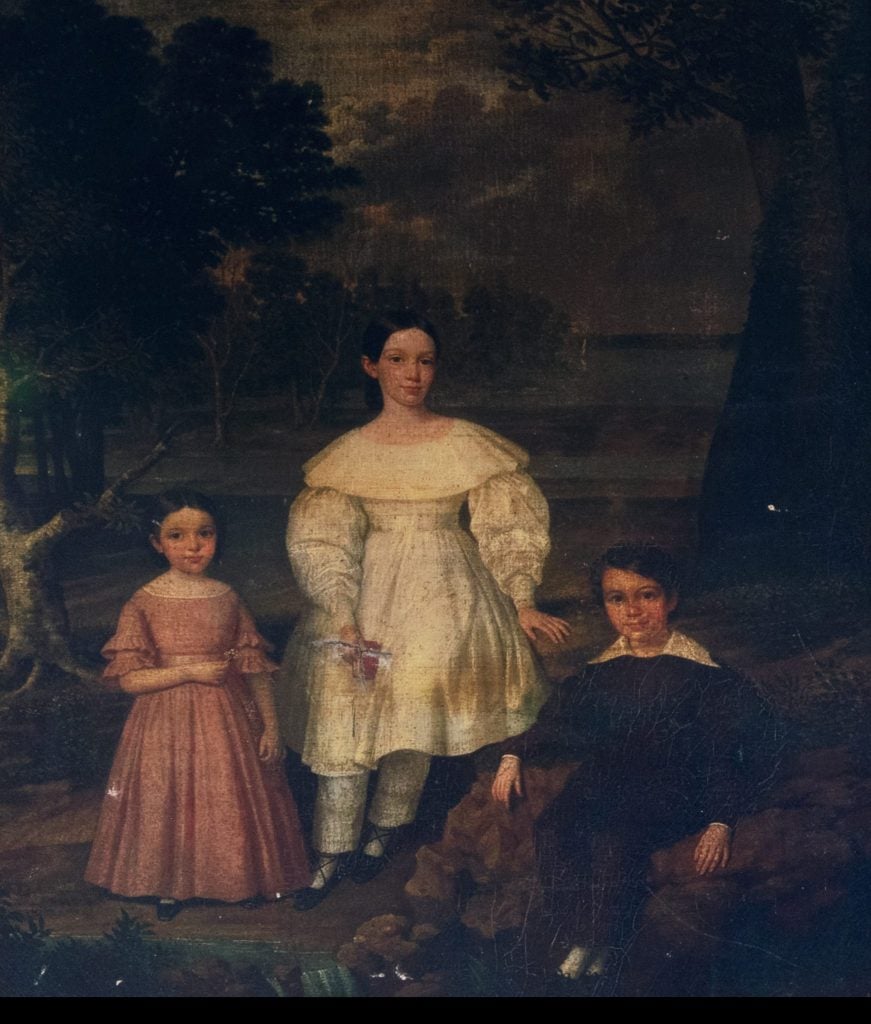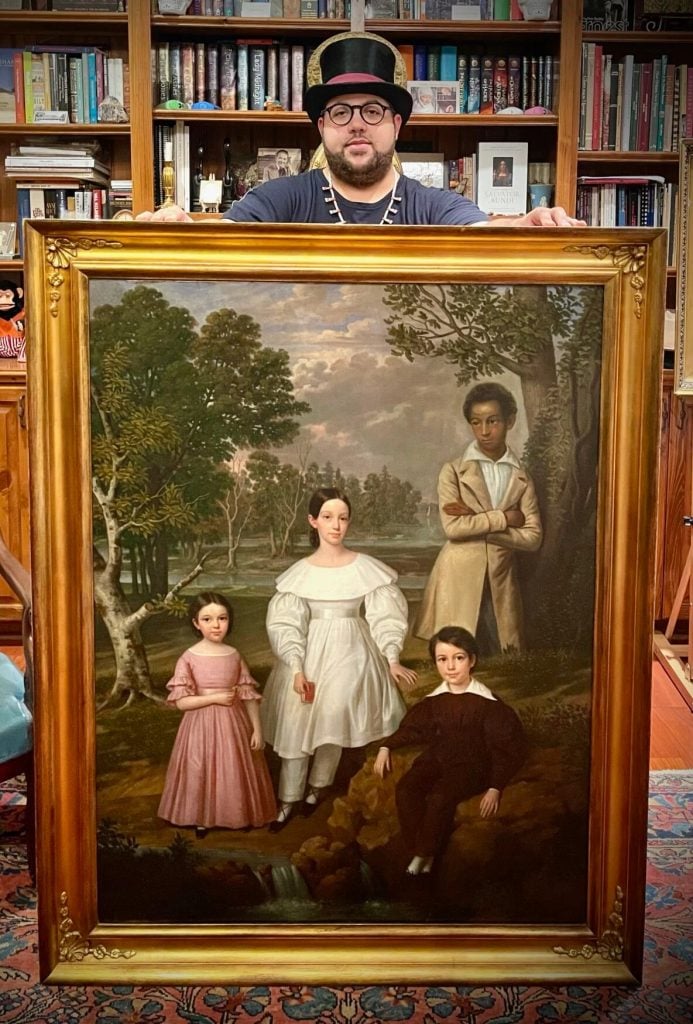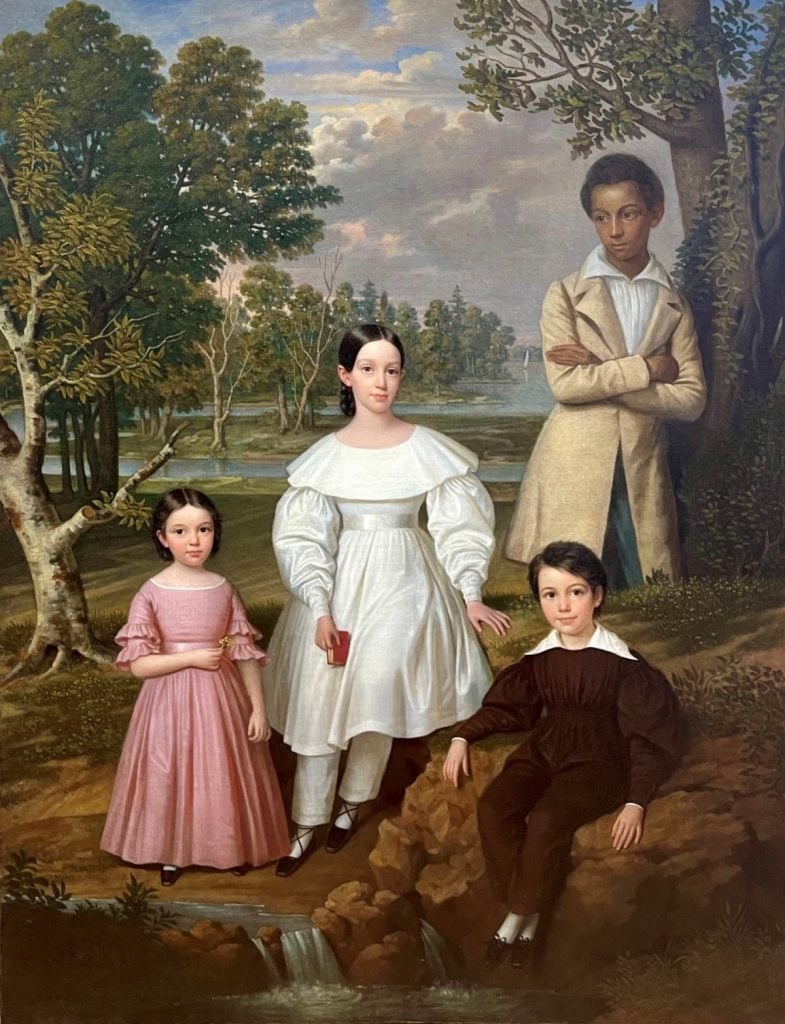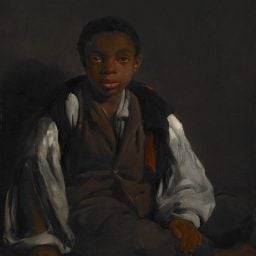New York’s Metropolitan Museum of Art has acquired a rare 19th-century portrait featuring an enslaved person, helping restore to view a young mixed-race boy who was painted out of history—figuratively and literally—for over 100 years. It will go on view in the museum’s American Wing this fall.
“The acquisition of this rare painting is transformative for the American Wing, representing our first naturalistic portrait of a named Black subject set in a Louisiana landscape—a work that allows us to address many collection absences and asymmetries as we approach the 100th anniversary of the wing’s founding in 2024,” Sylvia Yount, curator of the Met’s American Wing, said in a statement.
The canvas, titled Bélizaire and the Frey Children, dates to about 1837, when it was commissioned by Frederick Frey, a German-born banker and merchant who lived in the French Quarter with his wife, Coralie D’Aunoy Frey, and their family. It depicts three of the couple’s children—Elizabeth, Léontine, and Frederick Jr.—and an enslaved teenager named Bélizaire.
Uncovering Bélizaire’s identity was a passion project spearheaded by Louisiana art collector Jeremy K. Simien, who turned to art history as a means of better understanding of his own family origins as a ninth-generation Creole of mixed African and European descent. He first saw a photo of the painting in 2013, in an old auction lot attributing the work to either Trevor Thomas Fowler or Theodore Sydney Moise. He was eventually able to track the canvas down thanks to an Instagram tip from art dealer Taylor Thistlethwaite.

Attributed to Jacques Guillaume Lucein Amans,Bélizaire and the Frey Children (ca. 1837) before it was restored, with the ghostly outline of the figure of an enslaved boy visible behind the white children. Photo courtesy of Christie’s New York.
The painting is believed to be by the hand of French neoclassical painter Jacques Guillaume Lucien Amans, who worked in New Orleans from the late 1830s through the 1850s. His record at auction is $165,000, set back in 2012 at Neal Auction Company in New Orleans, according to the Artnet Price Database.
The Frey portrait shows a surprising intimacy between the four children, suggesting that Bélizaire was a valued member of the household, despite his enslaved status. But at some point around the turn of the century, someone painted over Bélizaire, not only erasing him from the Frey family history, but obscuring a rare example from the era of a realistic portrait of an enslaved person.
In 1972, Coralie’s great-great granddaughter, Audrey Grasser, donated the painting to the New Orleans Museum of Art. The faint outline of a fourth figure in the composition, she told the museum, was the remnants of the portrait of an enslaved person.
However, the institution chose not to do anything with that information. The painting languished in museum storage until 2005, when it was deaccessioned at auction, selling for $7,200 at Christie’s New York.
“I think in hindsight, it was a mistake, yes—but mistakes happen,” John Bullard, the museum’s director at the time of the sale, told the New York Times.
The buyer was an antiques dealer who restored the work, removing the overpainting obscuring Bélizaire from view. Simien bought it in 2021 for an undisclosed price, and had it restored again by conservator Craig Crawford. He also enlisted Louisiana historian Katy Morlas Shannon, who was able to figure out Bélizaire’s name and year of birth, 1822, thanks to census records.

Jeremy K. Simien with Bélizaire and the Frey Children, attributed to Jacques Guillaume Lucein Amans, after it was restored, removing overpainting that obscured the figure of an enslaved boy. Photo courtesy of Jeremy K. Simien.
It does not appear that Bélizaire was related to the Freys—state property records show that the family purchased the boy and his mother, Sally, when he was just six years old. Around 15 at the time of the portrait, he was likely the caretaker of the children in the painting, none of whom lived to adulthood. Coralie Frey sold Bélizaire to the Evergreen Plantation—where Shannon now works as head of history and interpretation—in 1856, and there are no records about his life after the start of the Civil War in 1861.
“This is a major discovery,” Shannon told Louisiana newspaper the Daily Advertiser. “People will know his name, they will see his face and he will be the surrogate stand-in for so many people whose pictures weren’t painted and stories weren’t told.”
Crawford believes the overpainting erasing Bélizaire was carried out in the late 19th- or early-20th-century—a time where Jim Crow laws reigned in the South, and a portrayal of white children and their enslaved caretaker as intimates would have been decidedly out of fashion. But even with Bélizaire back in the picture, the painting—where he stands in the background, removed from the other children—illustrates the complexities and layers of trauma inherent in enslavement.
“With great skill, [Amans] revealed the nuanced racial tension of the time in the composition, portraying fifteen-year-old Bélizaire lost in thought and subtly set apart from the children of his White enslaver,” said Elizabeth Kornhauser, curator emerita at the Met who retired this summer from the department of American painting and sculpture.
The painting comes to the Met after going on view last year in a special exhibition at New Orleans’s Ogden Museum of Southern Art. Simien will be sorry to part with it, but felt strongly the painting needed to go to a museum—this time one that would properly appreciate it.
“The aura was too great to be in a private collection,” he told the Times-Picayune. “I had a duty to place it somewhere with the best interpretation, the safest, where it wouldn’t be forgotten again.”
More Trending Stories:
The British Museum Has Reached a Settlement With a Translator Whose Work Was Used in an Exhibition Without Her Permission
Known as a Deep-Pocketed, ‘Aggressive’ Chinese Collector, Ding Yixiao Has Now Been Blacklisted by the Art Market. What Happened?
A German Court Rules That Martin Kippenberger’s Estate Must Name a Painter Who Executed His Works as a Co-Author
Can a Digital Artwork Outlast a 19th-Century Painting? The Answer Is Complicated as Artists, Dealers, and Conservators Battle Obsolescence in the Field
A Sculptor’s Lawsuit Against Kevin Costner Over Artwork She Created for His Planned Luxury Resort Will Finally Go to Trial
Creepily, the Woody Allen Romp ‘Vicky Cristina Barcelona’ Channels the Book That Outed Picasso’s Treatment of Women
JTT, the New York Gallery Known for Minting Star Artists, Is Closing After More Than a Decade
The British Library Has Discovered Scandalous Details Censored From the Official Account of Elizabeth I’s Reign











